Effect of Forest Greening on Carbonate Rock Weathering Carbon Sink in the Subtropical Humid Zone
Abstract
1. Introduction
2. Materials and Methods
2.1. Research Framework and Innovation Point
2.2. Study Area
2.3. Data Source
2.4. Quantification of Carbonate Rock Weathering Carbon Sink
2.4.1. Ki Parameter Quantization
2.4.2. Quantification of Ca2+ and HCO3− Activity Coefficients
2.4.3. Quantification of CO2 Partial Pressure
2.5. Correlation Between Factors and Carbonate Rock Weathering Carbon Sink
2.6. Statistical Analysis
3. Results
3.1. Vegetation Change Pattern and Trend
3.2. Pattern and Trend of Carbonate Rock Weathering Carbon Sink Flux
3.3. Correlation Analysis Between Variables and Carbonate Rock Weathering Carbon Sink
3.4. The Effect of Forest Greening on Carbonate Rock Weathering Carbon Sink
4. Discussion
4.1. Mechanism of Forest Greening Promoting Carbonate Rock Weathering Carbon Sink
4.2. Comparison and Verification of Research Results
4.3. Supplements and Uncertainties to Existing Knowledge
5. Conclusions
Author Contributions
Funding
Data Availability Statement
Acknowledgments
Conflicts of Interest
Abbreviations
| NDVI | Normalized difference vegetation index |
| CCS | Carbonate rock weathering carbon sink |
References
- Zeng, S.; Liu, Z.; Kaufmann, G. Sensitivity of the global carbonate weathering carbon-sink flux to climate and land-use changes. Nat. Commun. 2019, 10, 5749. [Google Scholar] [CrossRef] [PubMed]
- Zhang, S.; Xiong, K.; Min, X.; Zhu, D. Vegetation vulnerability in karst desertification areas is related to land–atmosphere feedback induced by lithology. Catena 2024, 247, 108542. [Google Scholar] [CrossRef]
- Zeng, S.; Jiang, Y.; Liu, Z. Assessment of climate impacts on the karst-related carbon sink in SW China using MPD and GIS. Glob. Planet. Change 2016, 144, 171–181. [Google Scholar] [CrossRef]
- Liu, Z.; Dreybrodt, W.; Wang, H. A new direction in effective accounting for the atmospheric CO2 budget: Considering the combined action of carbonate dissolution, the global water cycle and photosynthetic uptake of DIC by aquatic organisms. Earth-Sci. Rev. 2010, 99, 162–172. [Google Scholar] [CrossRef]
- Bai, X.; Zhang, S.; Smith, P.; Li, C.; Xiong, L.; Du, C.; Xue, Y.; Li, Z.; Long, M.; Li, M. Resolving controversies surrounding carbon sinks from carbonate weathering. Sci. China Earth Sci. 2024, 67, 2705–2717. [Google Scholar] [CrossRef]
- Wu, L.; Bai, X.; Li, C.; Li, H.; Cao, Y.; Ran, C.; Zhang, S.; Xiong, L.; Du, C.; Luo, G. Assessment of carbon sinks caused by the chemical weathering of carbonate rocks under the influence of exogenous acids: Methods, progress, and prospects. Sci. China Earth Sci. 2025, 68, 1785–1804. [Google Scholar] [CrossRef]
- Zhang, M.; Yang, W.; Yang, M.; Yan, J. Guizhou karst carbon sink and sustainability—An overview. Sustainability 2022, 14, 11518. [Google Scholar] [CrossRef]
- Zeng, S.; Liu, Z.; Jiang, Y.; Goldscheider, N.; Yang, Y.; Zhao, M.; Sun, H.; He, H.; Shao, M.; Shi, L. A greening Earth has reversed the trend of decreasing carbonate weathering under a warming climate. Nat. Commun. 2025, 16, 2583. [Google Scholar] [CrossRef]
- Du, C.; Bai, X.; Li, Y.; Tan, Q.; Zhao, C.; Luo, G.; Wu, L.; Chen, F.; Li, C.; Ran, C. Storage, form, and influencing factors of karst inorganic carbon in a carbonate area in China. Sci. China Earth Sci. 2024, 67, 725–739. [Google Scholar] [CrossRef]
- Li, H.; Wang, S.; Bai, X.; Cao, Y.; Wu, L. Spatiotemporal evolution of carbon sequestration of limestone weathering in China. Sci. China Earth Sci. 2019, 62, 974–991. [Google Scholar] [CrossRef]
- Yang, Y.; Roderick, M.L.; Guo, H.; Miralles, D.G.; Zhang, L.; Fatichi, S.; Luo, X.; Zhang, Y.; McVicar, T.R.; Tu, Z. Evapotranspiration on a greening Earth. Nat. Rev. Earth Environ. 2023, 4, 626–641. [Google Scholar] [CrossRef]
- Tong, X.; Brandt, M.; Yue, Y.; Horion, S.; Wang, K.; De Keersmaecker, W.; Tian, F.; Schurgers, G.; Xiao, X.; Luo, Y. Increased vegetation growth and carbon stock in China karst via ecological engineering. Nat. Sustain. 2018, 1, 44–50. [Google Scholar] [CrossRef]
- Zhang, X.; Brandt, M.; Tong, X.; Ciais, P.; Yue, Y.; Xiao, X.; Zhang, W.; Wang, K.; Fensholt, R. A large but transient carbon sink from urbanization and rural depopulation in China. Nat. Sustain. 2022, 5, 321–328. [Google Scholar] [CrossRef]
- Zhao, M.; Li, D.; Liu, Z.; Bao, Q.; Xia, F.; Yan, H.; Chen, B.; Hu, Y.; Cai, G.; Lang, R. Karst carbon sink mechanism and its contribution to carbon neutralization under land-use management. Sci. Total Environ. 2024, 937, 173381. [Google Scholar] [CrossRef]
- Berner, R.A. The rise of plants and their effect on weathering and atmospheric CO2. Science 1997, 276, 544–546. [Google Scholar] [CrossRef]
- Liu, Z.; Li, Q.; Sun, H.; Wang, J. Seasonal, diurnal and storm-scale hydrochemical variations of typical epikarst springs in subtropical karst areas of SW China: Soil CO2 and dilution effects. J. Hydrol. 2007, 337, 207–223. [Google Scholar] [CrossRef]
- Zheng, Y.; Ding, H.; Zhong, J.; Lang, Y.; Li, S.-L.; Xu, S.; Liu, C.-Q. Predominant biogenic contribution of dissolved inorganic carbon in karst rivers, Southwest China. Chem. Geol. 2024, 670, 122404. [Google Scholar] [CrossRef]
- Xi, H.; Wang, S.; Bai, X.; Tang, H.; Luo, G.; Li, H.; Wu, L.; Li, C.; Chen, H.; Ran, C. The responses of weathering carbon sink to eco-hydrological processes in global rocks. Sci. Total Environ. 2021, 788, 147706. [Google Scholar] [CrossRef]
- Tian, L.; Zhang, B.; Chen, S.; Wang, X.; Ma, X.; Pan, B. Large-scale afforestation enhances precipitation by intensifying the atmospheric water cycle over the Chinese Loess Plateau. J. Geophys. Res. Atmos. 2022, 127, e2022JD036738. [Google Scholar] [CrossRef]
- Chang, J.; Yue, Y.; Tong, X.; Brandt, M.; Zhang, C.; Zhang, X.; Qi, X.; Wang, K. Rural outmigration generates a carbon sink in South China karst. Prog. Phys. Geogr. Earth Environ. 2023, 47, 655–667. [Google Scholar] [CrossRef]
- Zhang, S.; Xiong, K.; Min, X.; Zhang, S. Demographic shrinkage promotes ecosystem services supply capacity in the karst desertification control. Sci. Total Environ. 2024, 917, 170427. [Google Scholar] [CrossRef]
- Piao, S.; Wang, X.; Park, T.; Chen, C.; Lian, X.; He, Y.; Bjerke, J.W.; Chen, A.; Ciais, P.; Tømmervik, H. Characteristics, drivers and feedbacks of global greening. Nat. Rev. Earth Environ. 2020, 1, 14–27. [Google Scholar] [CrossRef]
- Gao, S.; Lü, Y.; Jiang, X. Increased precipitation and vegetation cover synergistically enhanced the availability and effectiveness of water resources in a dryland region. J. Hydrol. 2025, 654, 132812. [Google Scholar] [CrossRef]
- Ye, T.; Huang, C.; Deng, Z. Spatial database of 1: 2500000 digital geologic map of People’s Republic of China. Geol. China 2017, 44, 19–24. (In Chinese) [Google Scholar] [CrossRef]
- Peng, S.; Ding, Y.; Liu, W.; Li, Z. 1 km monthly temperature and precipitation dataset for China from 1901 to 2017. Earth Syst. Sci. Data 2019, 11, 1931–1946. [Google Scholar] [CrossRef]
- Min, X.; Zhang, S.; Xiong, K.; Wang, L.; Yang, Q. Pattern and driver of Rosa roxburghii Tratt suitability and its effect on ecological services in karst desertification control areas. NPJ Herit. Sci. 2024, 12, 422. [Google Scholar] [CrossRef]
- Li, Y.; Peng, L.; Li, S.; Yue, Y.; Wang, K. Integrating transfer entropy and network analysis to explore social-ecological resilience evolution: A case study in South China Karst. J. Clean. Prod. 2025, 518, 145926. [Google Scholar] [CrossRef]
- Tong, X.; Brandt, M.; Yue, Y.; Ciais, P.; Jepsen, M.R.; Penuelas, J.; Wigneron, J.-P.; Xiao, X.; Song, X.-P.; Horion, S. Forest management in southern China generates short term extensive carbon sequestration. Nat. Commun. 2020, 11, 129. [Google Scholar] [CrossRef]
- Gombert, P. Role of karstic dissolution in global carbon cycle. Glob. Planet. Change 2002, 33, 177–184. [Google Scholar] [CrossRef]
- Plummer, L.N.; Busenberg, E. The solubilities of calcite, aragonite and vaterite in CO2-H2O solutions between 0 and 90 °C, and an evaluation of the aqueous model for the system CaCO3-CO2-H2O. Geochim. Cosmochim. Acta 1982, 46, 1011–1040. [Google Scholar] [CrossRef]
- Breiman, L. Random forests. Mach. Learn. 2001, 45, 5–32. [Google Scholar] [CrossRef]
- Brun, P.; Zimmermann, N.E.; Hari, C.; Pellissier, L.; Karger, D.N. CHELSA-BIOCLIM+ A novel set of global climate-related predictors at kilometre-resolution. EnviDat 2022. [Google Scholar] [CrossRef]
- Brook, G.A.; Folkoff, M.E.; Box, E.O. A world model of soil carbon dioxide. Earth Surf. Process. Landf. 1983, 8, 79–88. [Google Scholar] [CrossRef]
- Pohlert, T.; Pohlert, M.T.; Kendall, S. Trend: Non-Parametric Trend Tests and Change-Point Detection. Available online: https://CRAN.R-project.org/package=trend (accessed on 17 August 2025).
- Calcagno, V.; de Mazancourt, C. glmulti: An R package for easy automated model selection with (generalized) linear models. J. Stat. Softw. 2010, 34, 1–29. [Google Scholar] [CrossRef]
- Zeng, S.; Liu, Z. Karst-related carbon sink and the carbon neutral potential by carbonate liming in non-karst areas in China. Chin. Sci. Bull. 2022, 67, 4116–4129. [Google Scholar] [CrossRef]
- Lian, X.; Jeong, S.; Park, C.-E.; Xu, H.; Li, L.Z.; Wang, T.; Gentine, P.; Peñuelas, J.; Piao, S. Biophysical impacts of northern vegetation changes on seasonal warming patterns. Nat. Commun. 2022, 13, 3925. [Google Scholar] [CrossRef] [PubMed]
- Gaillardet, J.; Dupré, B.; Louvat, P.; Allegre, C. Global silicate weathering and CO2 consumption rates deduced from the chemistry of large rivers. Chem. Geol. 1999, 159, 3–30. [Google Scholar] [CrossRef]
- Cui, J.; Ding, J.; Lian, X.; Wei, Z.; Li, S.; Peng, J.; Poyatos, R.; Wang, T.; Piao, S. Observational constraints and attribution of global plant transpiration changes over the past four decades. Geophys. Res. Lett. 2024, 51, e2024GL108302. [Google Scholar] [CrossRef]
- Wu, J.; Feng, Y.; Li, L.Z.; Ciais, P.; Piao, S.; Chen, A.; Zeng, Z. Earth greening mitigates hot temperature extremes despite the effect being dampened by rising CO2. One Earth 2024, 7, 100–109. [Google Scholar] [CrossRef]
- Jasechko, S.; Sharp, Z.D.; Gibson, J.J.; Birks, S.J.; Yi, Y.; Fawcett, P.J. Terrestrial water fluxes dominated by transpiration. Nature 2013, 496, 347–350. [Google Scholar] [CrossRef]
- Meier, R.; Schwaab, J.; Seneviratne, S.I.; Sprenger, M.; Lewis, E.; Davin, E.L. Empirical estimate of forestation-induced precipitation changes in Europe. Nat. Geosci. 2021, 14, 473–478. [Google Scholar] [CrossRef]
- Ma, Z.; Wang, Y.; Gao, Z. An EOF-based study of precipitation characteristics and their responses to different configurations of summer monsoon in the East Asian monsoon region from 1951 to 2020. Plateau Meteorol. 2024, 43, 855–867. (In Chinese) [Google Scholar] [CrossRef]
- Du, C.; Ge, S.; Song, P.; Jombach, S.; Fekete, A.; Valánszki, I. Optimizing urban green spaces for vegetation-based carbon sequestration: The role of landscape spatial structure in Zhengzhou parks, China. Forests 2025, 16, 679. [Google Scholar] [CrossRef]
- Xu, X.; Li, K.; Li, C.; Han, F.; Zhao, J.; Li, Y. Spatial and chronological assessment of variations in carbon stocks in land-based ecosystems in Shandong Province and prospective predictions (1990 to 2040). Sustainability 2025, 17, 2424. [Google Scholar] [CrossRef]
- Deighton, H.D.; Bell, F.W.; Lindo, Z. Long-term effects of forest management on boreal forest soil organic carbon. Forests 2025, 16, 902. [Google Scholar] [CrossRef]
- Sun, S.; Li, Q.; Li, J.; Wang, G.; Zhou, S.; Chai, R.; Hua, W.; Deng, P.; Wang, J.; Lou, W. Revisiting the evolution of the 2009–2011 meteorological drought over Southwest China. J. Hydrol. 2019, 568, 385–402. [Google Scholar] [CrossRef]
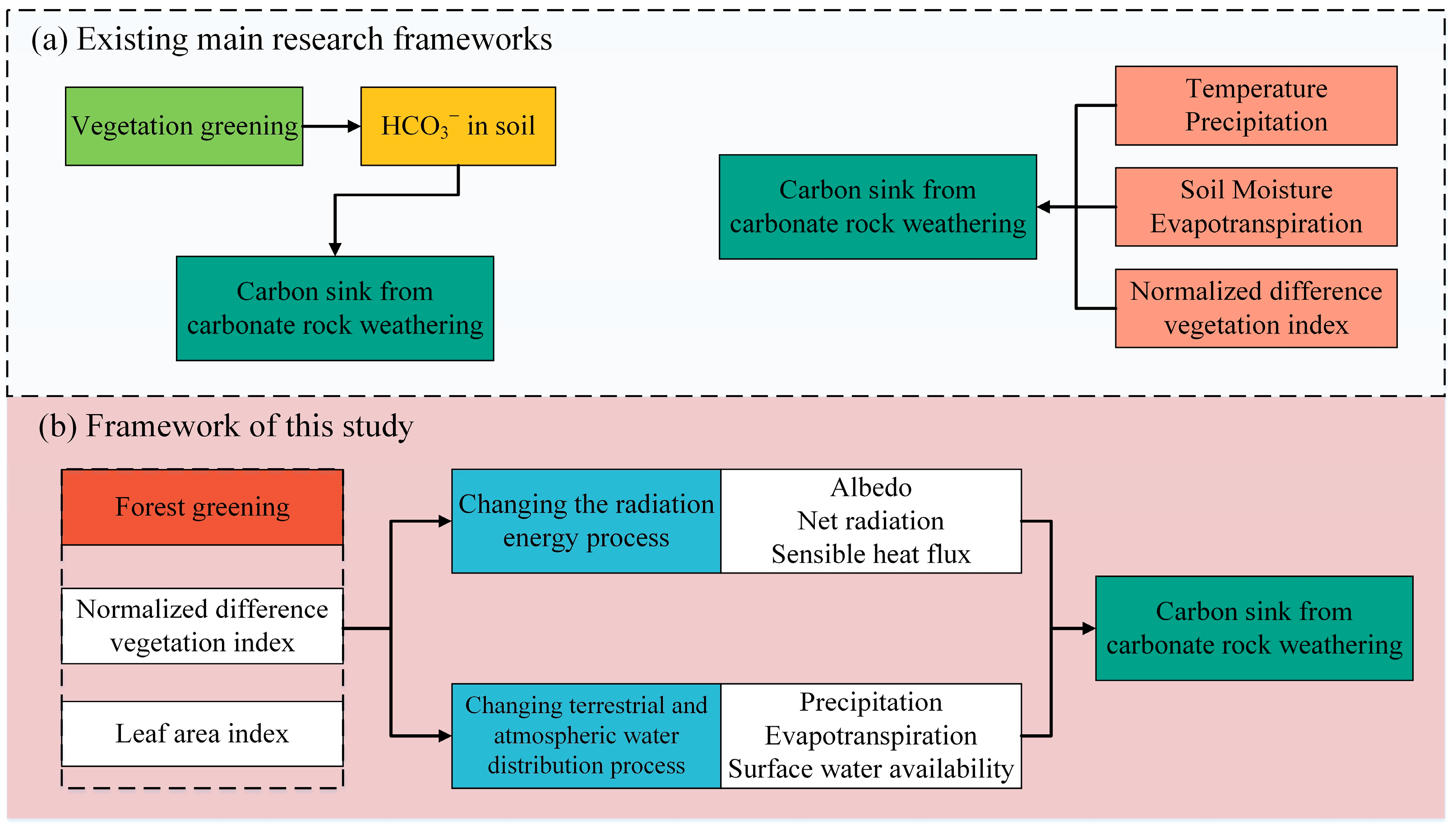
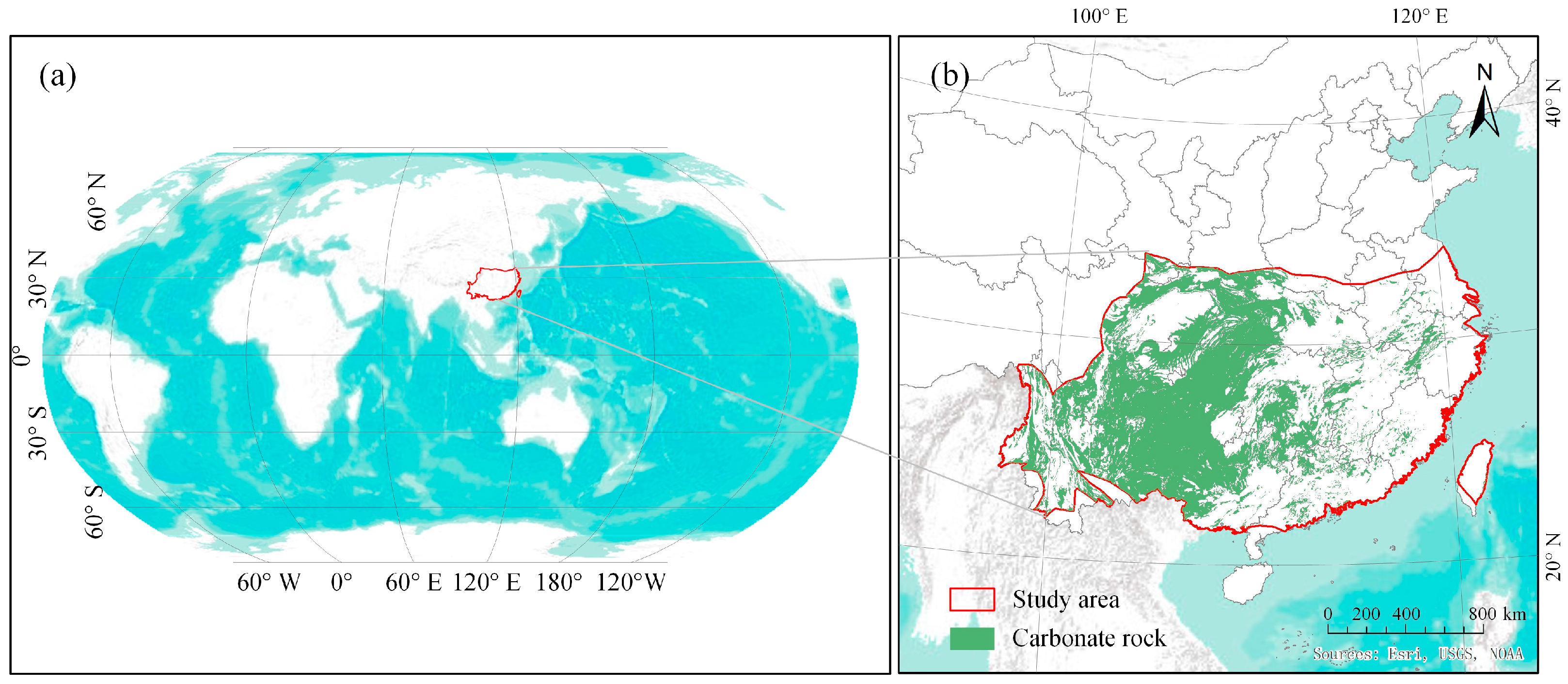
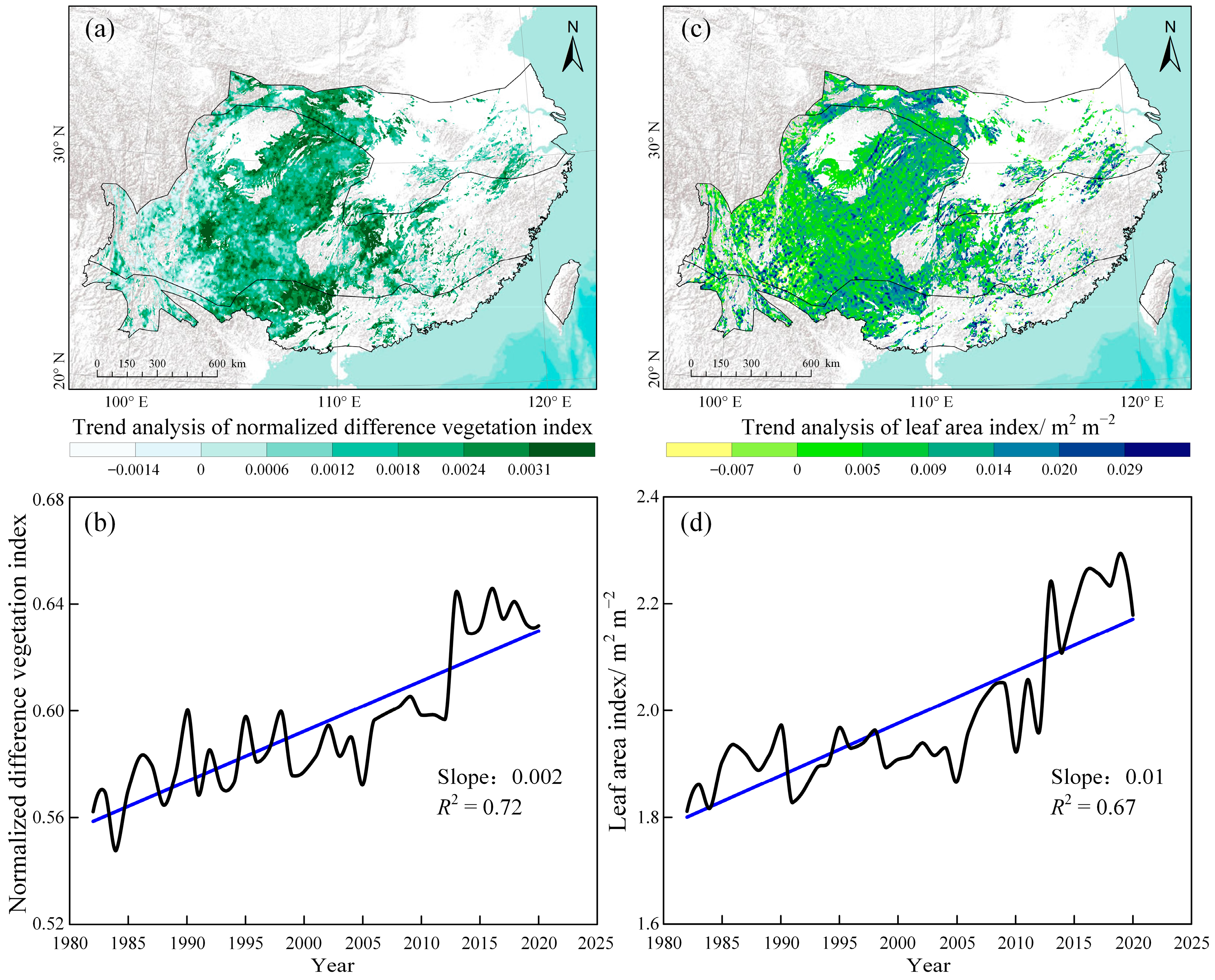
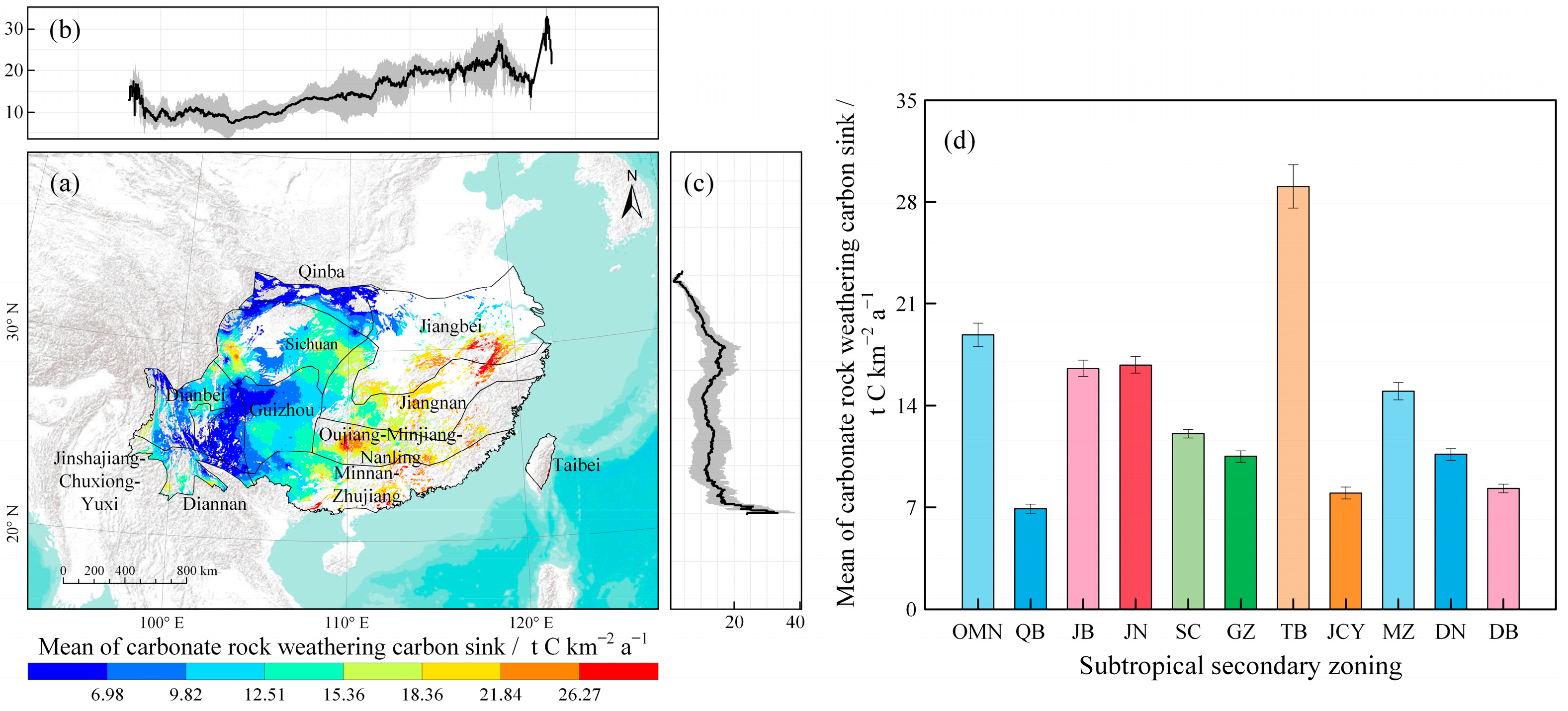
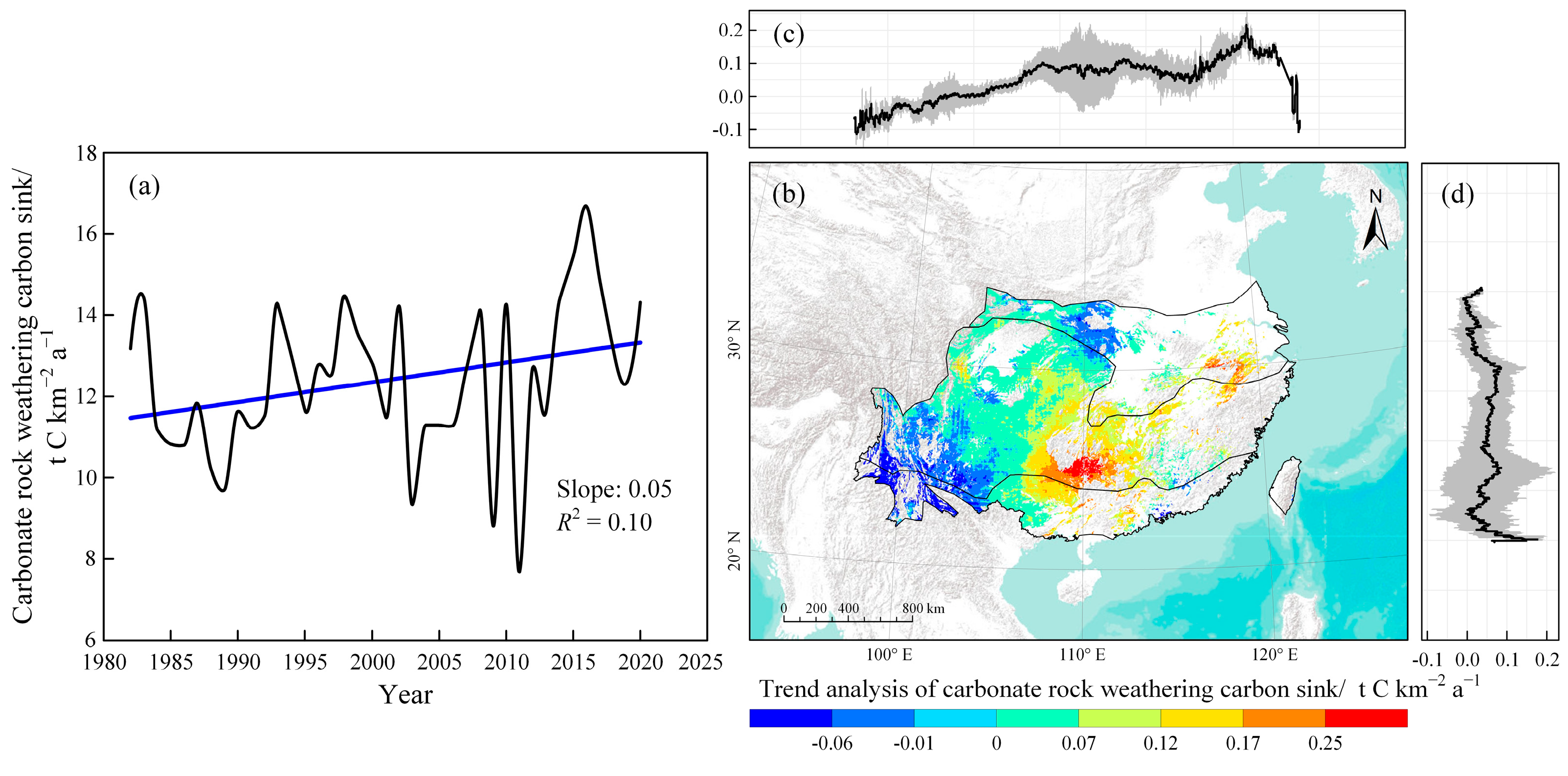
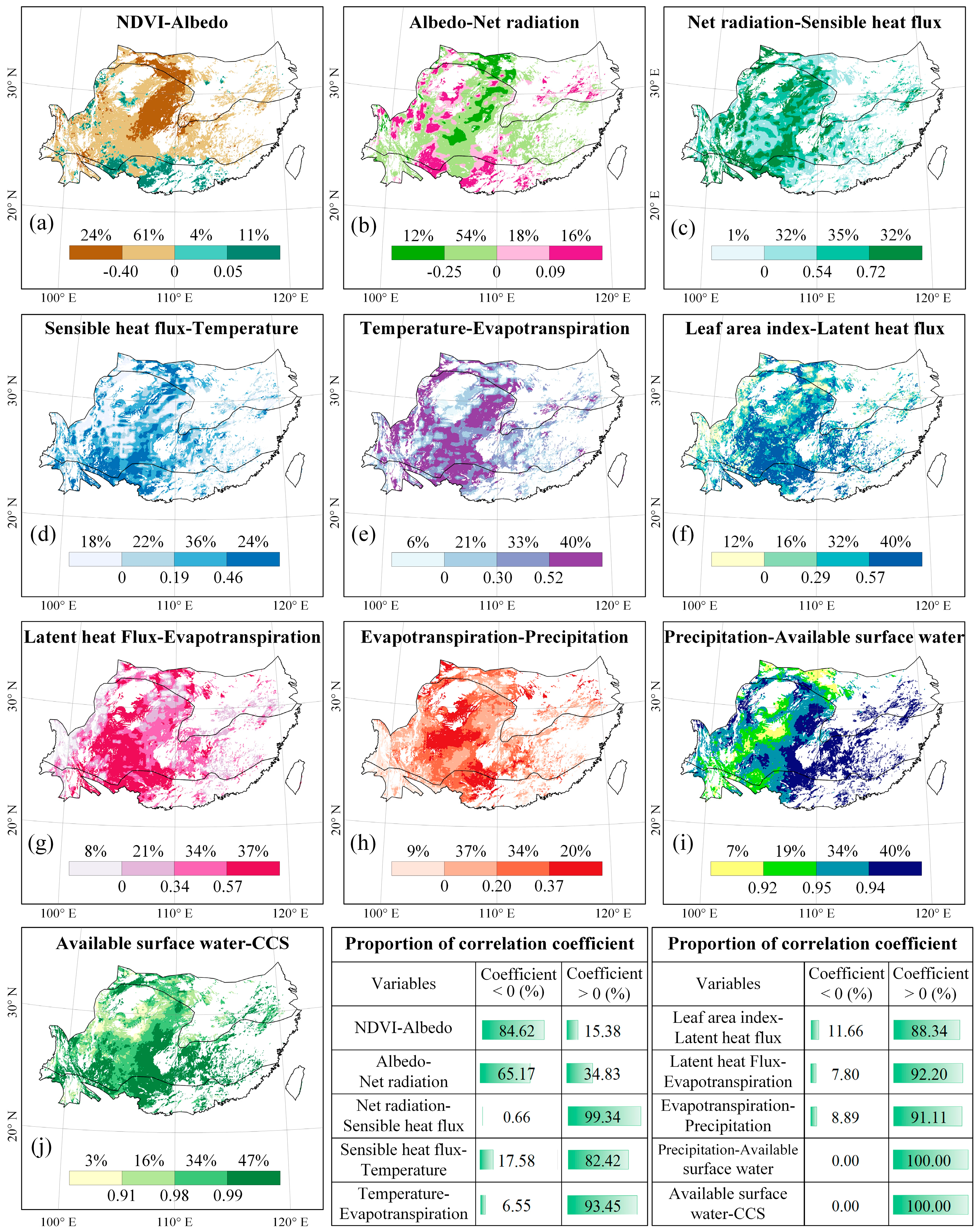

| Variables | Data Source | Resolution | Uses |
|---|---|---|---|
| Evapotranspiration (ET) | National Earth System Science Data Center (https://www.geodata.cn/) | 0.05° × 0.05° | These data are used to quantify CCS flux using thermodynamic dissolution models. |
| Precipitation (PRE) | National Tibetan Plateau Data Center (https://data.tpdc.ac.cn) | 1 km × 1 km | |
| Temperature (TEM) | National Tibetan Plateau Data Center (https://data.tpdc.ac.cn) | 1 km × 1 km | |
| Normalized difference vegetation index | ORNL DAAC (https://daac.ornl.gov/) | 0.083° × 0.083° Approximately 9222 m × 9222 m | These data are used to construct the interaction process between forest greening and CCS. |
| Leaf area index (NDVI) (LAI) | National Earth System Science Data Center (https://doi.org/10.5194/essd-15-4181-2023) | ||
| Albedo | ERA5-land (https://cds.climate.copernicus.eu/datasets?q=era5-land) | 11,132 m × 11,132 m | |
| Net radiation | |||
| Sensible heat flux | |||
| Latent heat flux |
| Shortname | Longtname | Unit |
|---|---|---|
| Bio1 | Annual air temperature | °C |
| Bio2 | Diurnal air temperature range | °C |
| Bio3 | Isothermality | °C |
| Bio4 | Temperature seasonality | °C/100 |
| Bio5 | Daily maximum air temperature of the warm | °C |
| Bio6 | Daily minimum air temperature of the coldest month | °C |
| Bio7 | Annual range of air temperature | °C |
| Bio8 | Daily mean air temperatures of the wettest quarter | °C |
| Bio9 | Daily mean air temperatures of the driest quarter | °C |
| Bio10 | Daily mean air temperatures of the warmest quarter | °C |
| Bio11 | Daily mean air temperatures of the coldest quarter | °C |
| Bio12 | Annual precipitation amount | kg m−2 yr−1 |
| Bio13 | Precipitation amount of the wettest month | kg m−2 month−1 |
| Bio14 | Precipitation amount of the driest month | kg m−2 month−1 |
| Bio15 | Precipitation seasonality | kg m−2 |
| Bio16 | Monthly precipitation amount of the wettest quarter | kg m−2 month−1 |
| Bio17 | Monthly precipitation amount of the driest quarter | kg m−2 month−1 |
| Bio18 | Monthly precipitation amount of the warmest quarter | kg m−2 month−1 |
| Bio19 | Monthly precipitation amount of the coldest quarter | kg m−2 month−1 |
| AI | Aridity index | - |
| CMI | Climate moisture index | kg m−2 month−1 |
| GSP | Growing season precipitation | kg m−2 gsl−1 |
| GST | Growing season temperature | °C |
| HUR | Near-surface relative humidity | % |
| NPP | Net primary productivity | g C m−2 yr−1 |
| PET | Potential evapotranspiration | kg m−2 month−1 |
| VPD | Vapor pressure deficit | Pa |
| Study Area | Research Methods | Karst Carbon Sink Flux/t C km−2 yr−1 | Karst Area/ 104 km−2 | Total Carbon Sink/104 t C yr−1 | Reference |
|---|---|---|---|---|---|
| China | Thermodynamic dissolution model | 6.93 | 253.97 | 1760 | Zeng and Liu [36] |
| Hunan | 11.83 | 8.39 | 98.98 | Du et al. [9] | |
| Fujian | Thermodynamic dissolution model | 13.83 | 0.82 | 11.30 | Du et al. [9] |
| Jiangxi | 14.13 | 3.21 | 45.38 | Du et al. [9] | |
| Subtropical | Thermodynamic dissolution model | 18.60 | − | − | Bai et al. [5] |
| China’s subtropical | 12.40 | 95.85 | 1188.54 | This study |
Disclaimer/Publisher’s Note: The statements, opinions and data contained in all publications are solely those of the individual author(s) and contributor(s) and not of MDPI and/or the editor(s). MDPI and/or the editor(s) disclaim responsibility for any injury to people or property resulting from any ideas, methods, instructions or products referred to in the content. |
© 2025 by the authors. Licensee MDPI, Basel, Switzerland. This article is an open access article distributed under the terms and conditions of the Creative Commons Attribution (CC BY) license (https://creativecommons.org/licenses/by/4.0/).
Share and Cite
Ma, X.; Ruan, H.; Yuan, F.; Qiu, H.; Chen, J.; Xiang, F.; Tang, C.; Tian, A.; He, G.; Guo, Y.; et al. Effect of Forest Greening on Carbonate Rock Weathering Carbon Sink in the Subtropical Humid Zone. Forests 2025, 16, 1391. https://doi.org/10.3390/f16091391
Ma X, Ruan H, Yuan F, Qiu H, Chen J, Xiang F, Tang C, Tian A, He G, Guo Y, et al. Effect of Forest Greening on Carbonate Rock Weathering Carbon Sink in the Subtropical Humid Zone. Forests. 2025; 16(9):1391. https://doi.org/10.3390/f16091391
Chicago/Turabian StyleMa, Xuewei, Huan Ruan, Fei Yuan, Hao Qiu, Jin Chen, Feng Xiang, Cheng Tang, Anhua Tian, Guibing He, Yingqun Guo, and et al. 2025. "Effect of Forest Greening on Carbonate Rock Weathering Carbon Sink in the Subtropical Humid Zone" Forests 16, no. 9: 1391. https://doi.org/10.3390/f16091391
APA StyleMa, X., Ruan, H., Yuan, F., Qiu, H., Chen, J., Xiang, F., Tang, C., Tian, A., He, G., Guo, Y., & Zhang, S. (2025). Effect of Forest Greening on Carbonate Rock Weathering Carbon Sink in the Subtropical Humid Zone. Forests, 16(9), 1391. https://doi.org/10.3390/f16091391






